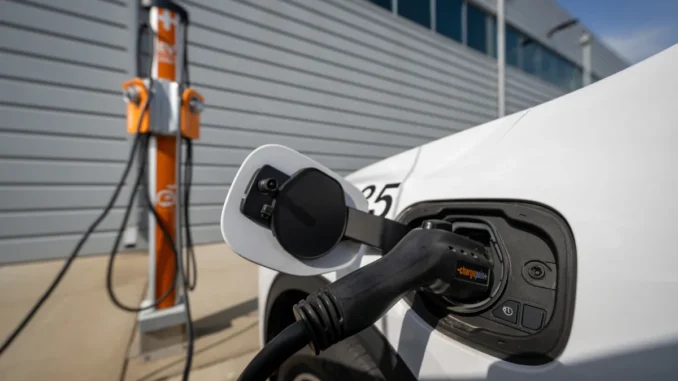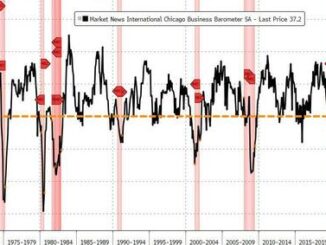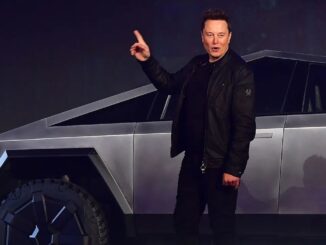
University Park is a small suburb south of Chicago, built around sprawling warehouses for companies like Clorox, Amazon and Solo Cup that attract a steady stream of diesel truck traffic. Its residents, 88% of whom are African American, are also exposed to pollution from a steel and wire processing facility relocated there from a gentrifying Chicago neighborhood, as well as steel mills and an oil refinery in nearby Northwest Indiana.
So, village manager Elizabeth Scott figured, the town was a prime candidate for improving quality of life and the environment by adopting electric vehicles — even if only two local households had EVs when Scott first checked the secretary of state’s website.
An EV Readiness program developed by the Chicago-area Metropolitan Mayors Caucus helped University Park catapult to being a leader in electric vehicle adoption, with the program offering a “blueprint” for preparing charging infrastructure, accessing grants and doing community outreach. University Park earned the second-highest score of a dozen municipalities participating in the first cohort to finish the EV Readiness program last year, and they were the only municipality in the region’s “Southland” to complete the program.
University Park is in the process of acquiring an EV charging station for electric semi-trucks city leaders hope will increasingly serve its warehouses, and they hope to add electric vehicles to their municipal fleet while also supporting residents to get their own EVs.
University Park’s EV Readiness website offers resources for local electric car owners and aspiring owners, from a video demonstrating how electric vehicles work to an interactive map of charging stations.
Scott, who has an electric car herself, had long noticed the vast disparity in available charging stations in the predominantly Black and Latino neighborhoods and suburbs on the South Side of Chicago, versus the wealthier and whiter neighborhoods and suburbs to the north.
“In Black and Brown communities there’s been a lot of disinvestment,” said Scott. “This [electric vehicle rollout] is big, it’s something new — for the world, and especially for this country.”
The truck charging station will be one of the first in the Midwest. “We’re kind of pioneers in this, this is uncharted territory,” Scott continued.
The EV Readiness program, funded by utility ComEd, offers guidance on a wide range of issues, including updating zoning and building codes to facilitate EV charger installation, training first responders in dealing with electric vehicle fires, and accessing federal and state incentives.
Municipalities receive scores for various achievements and can earn bronze, silver or gold certification through the program. Doing a fleet assessment to prepare to acquire municipal EVs helps earn silver certification, for example, and actually adding EVs to the fleet earns gold. Oak Park received a gold certification during the program’s first cohort, with the rest of the municipalities earning bronze.
The cohort of participating municipal leaders received guidance and instruction from the Mayors Caucus and met regularly.
“It was like a support group, to be able to partner with other communities, bounce ideas off one another,” Elizabeth Scott said. “I highly recommend every municipality to go through the program.”
Between October 2022 and November 2023, according to state registration data, the total number of EVs owned in the municipalities participating in the first cohort increased from 2,175 to 3,608. Hanover Park doubled its EV ownership, from 105 to 219, and Oak Park increased ownership from 581 to 904. Much-smaller University Park doubled its EV ownership — from eight to 16 vehicles.
The concept of EV Readiness was born in 2018 during public meetings around the Volkswagen vehicle emissions cheating settlement that provided funding to states for alternative fuels and electric vehicles. Metropolitan Mayors Caucus director of environmental initiatives Edith Makra noted that the majority of public comments made during that period were focused on acquiring electric vehicles.
The caucus launched the initiative with a series of listening sessions with stakeholders including the IBEW electrical workers union, fire safety officials, advocacy groups and municipal leaders. The caucus developed an EV Readiness checklist, certification program and curriculum. The first cohort of municipalities started the program in December 2022 and “graduated” in December 2023.
“When we first signed on to support this program, we weren’t fully sure what the response from municipalities would be,” said ComEd external affairs director Philip Roy. “We were kind of blown away by the interest. We have over 400 municipalities in our service territory, that are all very different — in size, makeup, resources, they all need different kinds of help. That’s where having a group like the Metropolitan Mayors Caucus that is so used to working with a broad, diverse set of municipalities is key to success.”
The EV Readiness program dovetails with an ongoing Metropolitan Mayors Caucus initiative known as the Greenest Region Compact that involves communities collaborating to develop and adopt sustainability standards.
EV Readiness also builds on the model of SolSmart, a nationwide technical assistance initiative that helps municipalities invest in and prepare for solar power, at no cost to them. Many of the municipalities in the first cohort of EV Readiness were also participants in SolSmart.
With both programs, part of the goal is to help communities be well-positioned to apply for federal grants and incentives.
“We wanted communities to be ready for the influx of funding that was on the way, we knew it was coming, we wanted to make sure they were thinking about it,” said Metropolitan Mayors Caucus sustainability specialist Cheryl Scott (no relation to Elizabeth Scott).
During the first cohort, the federal government announced the National Electric Vehicle Infrastructure (NEVI) program providing grants for EV charging under the 2021 Bipartisan Infrastructure Law. The smallest grants available were $2 million, “more than most of our communities need,” as Makra said. And ironically the paperwork to apply for the environmental justice-focused Justice 40 mandates of the program was “a really heavy lift for most small communities,” as Makra said.
So, the Mayors Caucus worked with communities to prepare an aggregated NEVI grant application, seeking $15 million to install 114 chargers in 35 towns and two counties. Recipients have not yet been announced.
Illinois has been a leader in legislation promoting electric vehicles on the state level. The 2021 Climate and Equitable Jobs Act created incentives for public transit electrification and EV ownership, with a goal of having one million EVs on Illinois roads by 2030. The law creates rebates of up to $4,000 for consumers who buy electric vehicles, and demands utilities pursue transportation electrification in an equitable way that does not burden customers who don’t own EVs.
Last year the Illinois legislature passed the Electric Vehicle Charging Act, which requires new single-family homes and multi-family buildings be EV capable, meaning conduit is laid to allow easy installation of chargers and wiring. State law also prohibits landlords and homeowners associations from unduly interfering with charger installation, and clarifies how renters should pay for electricity used in charging EVs.
ComEd funded the first two cohorts of EV Readiness with $225,000, and the utility is in the process of finalizing increased funding for additional cohorts, said Roy. The second cohort of the program – including 16 municipalities and two counties – is underway.
During a recent luncheon sponsored by the Executives’ Club of Chicago, ComEd CEO Gil Quiniones touted the Metropolitan Mayors Caucus’s work and the importance of EV rollout.
“We want to make sure our grid is ready, if someone wants to buy an electric vehicle today and put in a charging station,” Quiniones said. “We want electric vehicles to be an easier choice for our customers.”
He said alleviating “range anxiety” by installing more charging stations is key. Currently, there are about 2,000 level 2 chargers and 1,000 fast-chargers in ComEd’s service territory, he said.
As part of its Beneficial Electrification program, ComEd is spending $231 million on rebates and other incentives to encourage electrical vehicle adoption by municipalities and individuals.
“We recognize that municipalities are going to play a vital role in the transition to electrification,” said Roy. “Many of the policies that drive how and where infrastructure is installed are very hyperlocal policies that municipalities oversee: zoning, parking code, use of public space.”
The mayors caucus helps municipalities coordinate with utilities on EV readiness and helps them understand suggested electrical code standards and practices.
Cheryl Scott said most municipalities require permits for level 2 or fast-charging stations, but not for level 1 charging.
“If it’s the same outlet as plugging a toaster in, should the government get involved?” she asked. “Level 1 is where we saw uncertainty about how to do that. If it’s an older house, older wiring could cause problems. The owners manual (for chargers) says check with an electrician.”
“Do you permit for EV charging at a residential level or not?” added Makra. “We ask a community to think that through. Do you risk being overly burdensome, or not necessarily protecting your constituents in terms of safe installation?”
The EV Readiness program encourages communities to adopt policies going beyond the state EV charging law, and some including University Park did so by requiring new commercial construction be EV-capable.
Oak Park, a suburb west of Chicago, adopted the “most transformative” charging infrastructure policy, in Cheryl Scott’s words. The town requires a level 2 charger be installed in any new residential building with a garage or parking space, and commercial buildings and multi-family residences must have a level 2 charger for every five parking spaces. Several towns including University Park also adopted policies that commercial construction must be EV-ready or EV-capable; the state law only applies to residential buildings.
Elizabeth Scott said she’s seen interest in EVs blossom in University Park since EV Readiness launched, for environmental and financial reasons.
She said she spent $350 a month on gasoline for her car before getting an EV, since her position requires constant driving. Now, she spends about $100 a month on charging.
“It’s convenient, it’s safer, I have no catalytic converter to steal, I don’t have oil changes,” Scott noted. “But it’s really an investment in the sustainability of our future and our communities. I’m really grateful we’re able to do this as a community of color that normally doesn’t have all the opportunities.”



